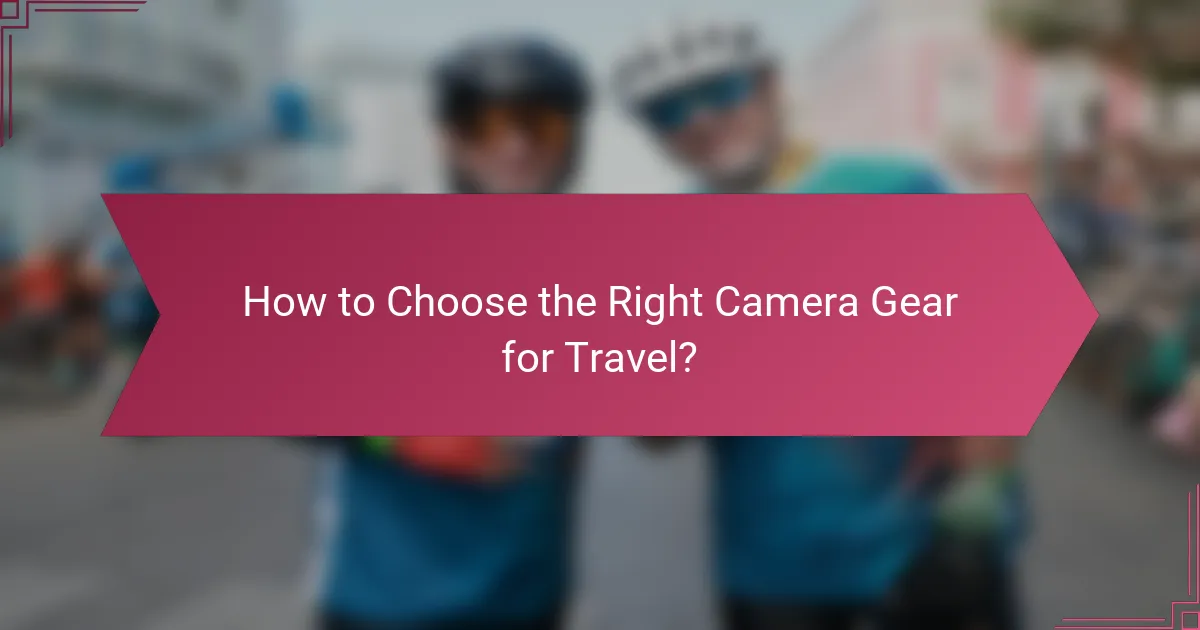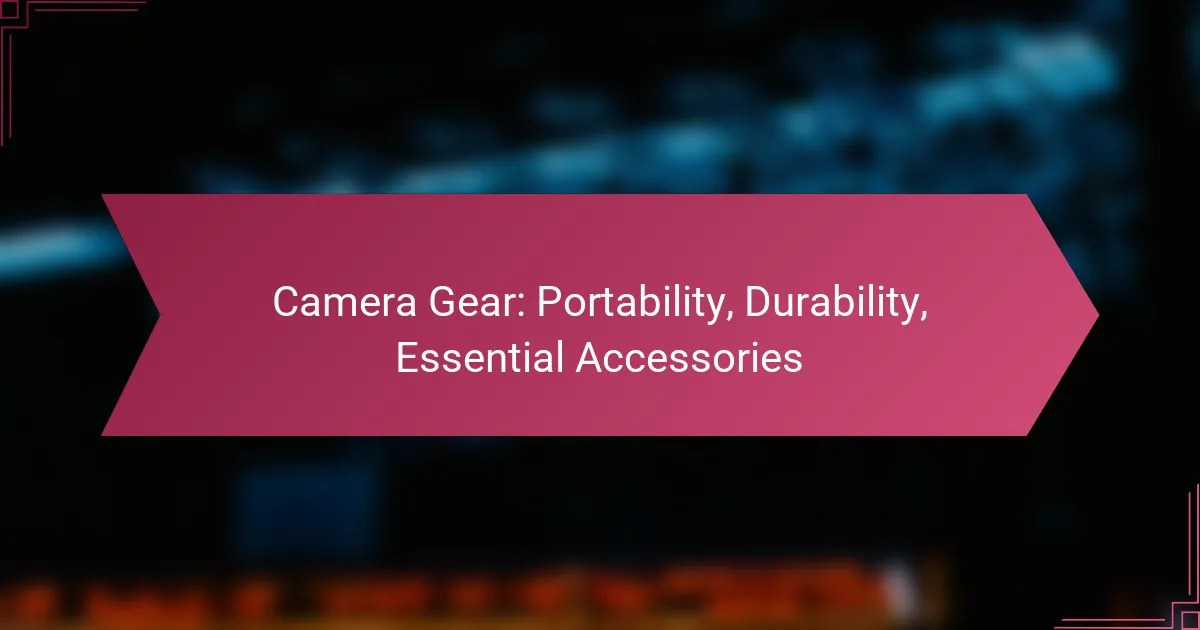When selecting camera gear, portability and durability are crucial for photographers on the go. Lightweight options like mirrorless cameras and compact tripods make travel easier, while durable equipment ensures reliability in various conditions. Additionally, essential accessories such as extra batteries and lens filters enhance your shooting experience, allowing you to capture the perfect shot without hassle.

What Are the Best Portable Camera Gear Options?
The best portable camera gear options combine lightweight design with durability, making them ideal for travel and outdoor photography. Key choices include mirrorless cameras, compact point-and-shoots, travel tripods, camera backpacks, and portable lighting solutions.
Mirrorless cameras
Mirrorless cameras are a top choice for photographers seeking portability without sacrificing image quality. They are generally lighter and more compact than traditional DSLRs, featuring interchangeable lenses and advanced technology.
When selecting a mirrorless camera, consider factors like sensor size, battery life, and lens availability. Popular models often weigh between 300 to 600 grams, making them easy to carry on long shoots.
Compact point-and-shoot cameras
Compact point-and-shoot cameras are designed for simplicity and convenience, making them perfect for casual photographers. These cameras typically feature fixed lenses and automatic settings, allowing users to capture quality images with minimal effort.
Look for models that offer good low-light performance and a decent zoom range, usually around 20x to 30x. Weighing under 300 grams, they fit easily in pockets or small bags.
Travel tripods
Travel tripods are essential for stabilizing your camera during long exposures or low-light conditions. They are designed to be lightweight and compact, often folding down to less than 40 cm for easy transport.
When choosing a travel tripod, consider the maximum height, weight capacity, and material. Aluminum tripods are sturdy but heavier, while carbon fiber options are lighter but more expensive. Aim for a tripod that weighs around 1 kg or less for optimal portability.
Camera backpacks
A good camera backpack protects your gear while providing comfort during travel. Look for backpacks with padded compartments, adjustable straps, and weather-resistant materials to safeguard your equipment.
Many camera backpacks also feature additional pockets for personal items and quick-access side openings. Choose a size that can comfortably hold your camera, lenses, and accessories without being cumbersome, typically around 20 to 30 liters in capacity.
Portable lighting solutions
Portable lighting solutions, such as LED panels or speedlights, enhance your photography in various lighting conditions. They are lightweight and often battery-operated, making them ideal for on-the-go shooting.
When selecting portable lights, consider their brightness (measured in lumens), color temperature, and battery life. A good portable light should provide adjustable settings and last several hours on a full charge, ensuring you are prepared for any situation.

How Durable Is Your Camera Gear?
Durability in camera gear refers to its ability to withstand various environmental conditions and physical impacts. Choosing durable equipment can significantly extend its lifespan and ensure reliable performance in challenging situations.
Weather-resistant models
Weather-resistant cameras are designed to function in adverse conditions, such as rain, dust, and extreme temperatures. Look for models with sealed bodies and weatherproofing ratings, often indicated by IP (Ingress Protection) codes. For example, a camera rated IPX6 can handle powerful water jets, making it suitable for outdoor photography.
When selecting a weather-resistant model, consider the type of photography you’ll be doing. If you frequently shoot in unpredictable weather, investing in a higher-end weather-sealed camera can be beneficial. Brands like Canon, Nikon, and Fujifilm offer various options across different price ranges.
Shockproof camera bodies
Shockproof camera bodies are built to withstand drops and impacts, making them ideal for adventurous photographers. These models often feature reinforced frames and rubberized grips to absorb shocks. For instance, some compact cameras are designed to survive falls from heights of around 1.5 meters.
When choosing a shockproof camera, assess your typical shooting environment. If you often find yourself in rugged terrains or crowded events, a shockproof model can provide peace of mind. Look for cameras with MIL-STD ratings, which indicate military-grade durability standards.
Durable lens options
Durable lenses are constructed with robust materials and often include weather sealing to protect against moisture and dust. Many professional-grade lenses from brands like Sigma and Tamron offer weather-resistant features, ensuring they can withstand harsh conditions without compromising image quality.
When selecting durable lenses, consider factors such as the type of photography you engage in and your budget. Prime lenses tend to be lighter and more compact, while zoom lenses offer versatility. Prioritize lenses with metal mounts and high-quality glass elements for enhanced durability.

What Essential Accessories Should You Have?
Essential accessories enhance your photography experience by ensuring you are prepared for various shooting conditions. Key items include extra batteries, memory cards, lens filters, and camera straps, each serving a specific purpose to improve your workflow and protect your gear.
Extra batteries
Having extra batteries is crucial for any photographer, especially during long shoots or when traveling. Depending on your camera model, consider carrying at least one or two spare batteries to avoid running out of power at critical moments.
When selecting batteries, opt for original manufacturer products or high-quality third-party options to ensure compatibility and performance. Keep them charged and ready to go, and remember to check their health regularly to avoid unexpected failures.
Memory cards
Memory cards are essential for storing your photos and videos, making it important to have several on hand. Look for cards with high write speeds and ample storage capacity, typically ranging from 32GB to 256GB or more, depending on your shooting style.
Consider using different cards for various purposes, such as high-capacity cards for video recording and smaller ones for casual photography. Always format your cards in-camera before use to ensure optimal performance and avoid data corruption.
Lens filters
Lens filters protect your camera lens and can enhance your images in various ways. Common types include UV filters for protection, polarizing filters to reduce glare, and ND filters for controlling exposure in bright conditions.
Investing in high-quality filters can improve image quality and safeguard your lens from scratches and dust. Always choose filters that match your lens diameter, and consider using a filter pouch for safe transport.
Camera straps
A reliable camera strap is essential for comfort and security while shooting. Look for straps that distribute weight evenly and allow for quick access to your camera, especially during long sessions or when moving between locations.
Consider options like padded neck straps, wrist straps, or even harness systems for heavier setups. Ensure the strap is compatible with your camera model and can support its weight to prevent accidents.

How to Choose the Right Camera Gear for Travel?
Choosing the right camera gear for travel involves balancing portability, durability, and essential accessories. Prioritize lightweight options that can withstand various conditions while ensuring you have the necessary tools for capturing quality images.
Weight considerations
When selecting camera gear for travel, weight is a crucial factor. Aim for a total gear weight of no more than 5-10 kg to keep your load manageable, especially during long trips. Consider lightweight materials like carbon fiber for tripods and compact lenses to minimize bulk.
Evaluate the weight of each item, including your camera body, lenses, and accessories. A good rule of thumb is to choose a camera body that weighs less than 1 kg and lenses that are under 500 grams each. This helps maintain a balance between quality and portability.
Functionality vs. size
Functionality and size often present a trade-off in camera gear selection. Larger cameras typically offer better image quality and features, but they can be cumbersome to carry. Compact mirrorless cameras are a popular choice, providing excellent performance without the bulk of traditional DSLRs.
Consider the types of photography you plan to do while traveling. If you need versatility, a zoom lens might be more functional despite being slightly larger. Conversely, if you prioritize portability, a prime lens may be a better fit, as they are usually smaller and lighter.

What Are the Best Brands for Portable and Durable Gear?
When it comes to portable and durable camera gear, brands like Canon, Nikon, and Fujifilm stand out for their reliability and quality. Each brand offers a range of products that cater to different needs, ensuring photographers can find gear that balances portability with durability.
Canon
Canon is renowned for its lightweight and robust camera systems, making it a top choice for travel photographers. Their EOS series, especially the mirrorless models, are designed for easy handling without compromising on image quality.
When selecting Canon gear, consider the lens options available, as they significantly affect both portability and performance. Canon’s EF-M lenses for mirrorless cameras are compact and versatile, ideal for on-the-go shooting.
Nikon
Nikon offers a solid lineup of cameras known for their durability and weather resistance, particularly in the D and Z series. These models are built to withstand challenging conditions, making them suitable for outdoor photography.
For portability, Nikon’s Z series mirrorless cameras are lightweight and feature a compact design. Pairing these cameras with NIKKOR Z lenses enhances mobility while maintaining high-quality images.
Fujifilm
Fujifilm is celebrated for its stylish and compact camera designs, particularly in the X series. These cameras are not only portable but also offer exceptional image quality and unique film simulation modes.
When choosing Fujifilm gear, look for the XF lens lineup, which is designed to be lightweight and versatile. This combination allows photographers to easily carry their equipment without sacrificing creative options.
